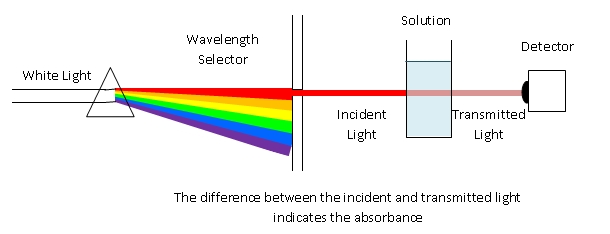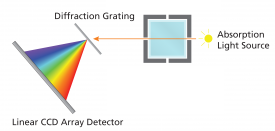
General Spectrophotometer diagram

Vernier SpectroVis Instrument diagram
We are collecting data to determine the rate law for this reaction:
2I–(aq) + 2Fe3+(aq) --> I2(aq) + 2Fe2+(aq)The rate law has the form:
Rate = k[Fe3+]a[I–]bThe task in this lab is to determine the values of a, b, and k. We will do so by using the method of initial rates. This works by comparing rates of reaction for different initial concentrations of reactants. By doing three experiments with carefully chosen initial concentrations it is possible to mathematically isolate the exponents. Once the exponents, or orders of reaction, are known for both reactants the value of k may be calculated from the known rate and known initial concentrations.

General Spectrophotometer diagram | 
Vernier SpectroVis Instrument diagram |
Colored chemicals absorb specific wavelengths of light. Yellow food color absorbs blue light very strongly. Blue food coloring absorbs red and orange light. This can easily be demonstrated using a spectrophotometer or with an overhead projector and a diffraction grating.
Absorbance of light at a particular wavelength can be used to measure the concentration of colored chemicals. The larger the concentration of a colored chemical, the darked the color, and the stronger the absorbance. The mathematical definition of absorbance is based on the percentage of light that is transmitted. To make a measurement, the brightness of the light source is measured with no sample or with a so-called blank. This provides the initial intensity. Once a sample is placed into the spectrophotometer the intensity of light at the chosen wavelength can be measured, which is reduced compared to the blank. The ratio of these intensities, expressed as a percent is called the percent transmittance. As a function of concentration the percent transmittance does not produce a linear relationship. By taking the negative log10 of the transmittance (expressed as a decimal) the absorbance may be calculated (A = -log(%T)). This calculation is performed automatically by the instrument. The absorbance is a measure of the amount by which a chemical has reduced the intensity of light. The higher the absorbance, the more strongly the light is absorbed. Absorbance has a simple, linear relationship to the concentration of a chemical and so it can be used to measure concentration. If measured as a function of time, absorbance provides a measure of changes in concentration. This is how we will use the instrument in this lab.

We will not attempt to collect data which directly connects absorbance to concentration but since they are directly proportional the rate of change of the absorbance will serve perfectly well to stand in for the true rate of reaction. The slope of a graph of absorbance (y-axis) vs. time (x-axis) will have units of A/s. When measured at 450 nm the absorbance increases as the reaction under study progresses. The reaction rate slows down as products build up and so it is not a constant with a simple linear appearance on the graph. In order to compare rates between experiments we will find an average rate of reaction by using Excel to calculate the slope of a linear trendline for a specific range of time, say from 10 s to 70 s.
In the sample data displayed at right the slope is about 5.6 × 10–3. This is the only number we need from the many data points you will collect. You will perform a given experiment three times, discard any trials which you know are poor data (based on your execution), and average the trials to find a rate of reaction for that experimental setup.
Given how rate is determined in these experiments a true value for k, the rate constant, cannot be calculated exactly. In order to be able to calculate a value we will be taking the rates determined here to be in units of M/s rather than A/s.
To find order of reaction you will use data from two experiments. Use the average rate and the calculated initial concentrations of reactants.
Experiment 1 Concentration of I–
(vol. of KI soln) 1.0 mL
------ × 0.020 M = 0.0067 M
(total volume) 3.0 mL
Experiment 3 Concentration of I–
(vol. of KI soln) 2.0 mL
------ × 0.020 M = 0.013 M
(total volume) 3.0 mL
Experiment 1 and 3 Concentration of Fe3+
(vol. of FeCl3 soln) 1.0 mL
------ × 0.020 M = 0.0067 M
(total volume) 3.0 mL
|
Rate = k[Fe3+]a[I–]b Rate1 = k[0.0067]a[0.0067]b --------------------------- Rate3 = k[0.0067]a[0.013]b 5.6 × 10–3 = k[0.0067]a[0.0067]b ---------------------------------- 1.1 × 10–2 = k[0.0067]a[0.013]b 0.5 = k/k × 1 × (0.5)b so b = 1 since only 0.51 = 0.5 |
You will use syringes to measure volumes. Do not use syringes in the bottles of stock solution to avoid possible contamination. Obtain about 10 - 12 mL of each solution in a separate, labeled beaker. Draw some solution into the syringe and then expell it in order to exclude air bubbles. Fill the syringe to a larger volume than what you need. Deliver the amount you need by difference between two points on the scale on the side of the syringe. For example, deliver 1.0 mL by pressing the plunger down so that it moves from 3 mL to 2 mL.
Use a different, clean cuvet for each experimental setup. Between trials carefully clean the cuvet and make it as dry as possible so that you do not affect the outcome of the next trial.
Always leave stock solution bottles tightly closed when not in immediate use!
Both stock solutions used in this lab experiment are dilute and so are relatively safe to use. As always, wash hands before leaving the lab, eating, or drinking, or going to the bathroom.
Potassium iodide (KI) is non-toxic.
Iron(III) chloride (FeCl3) is corrosive, toxic, and causes stains. At the concentration provided it has a very low risk of causing harm but treat it with care nonetheless.
The iodine (I2) produced in the reaction is corrosive and toxic but is produced in minute amounts in this lab and so is of minor concern.
Collect all waste in the designated bottle by pouring the solution out of the cuvet, rinsing the cuvet by filling it once with tap water and pouring it into the bottle, and the closing the bottle again. Use the funnel provided to make splashing outside the bottle less likely.